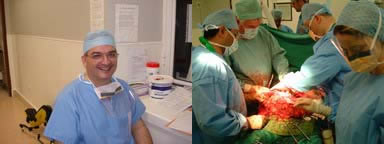 |
 |
|
|
All images, illustrations & flash animation are copyrighted to Deya Marzouk, unless stated otherwise. Copy is prohibited without written permission. Innovative techniques mentioned in this web site were all devised by Deya Marzouk. Please Credit Deya Marzouk if any material is copied from here (with prior permission only) |
A tear in the margin of the anus
Acute fissures: Superficial. No induration. No skin tag.
Chronic fissure: Deeper down to internal sphincter. Associated induration, fibrosis, skin tags and anal polyps. Rarely may result in anal stenosis.
The two commonest symptoms are pain & bleeding. Pain during & after defecation occur in 75-100% of patients. Bright rectal bleeding also occur in 75-100% of patients and is generally slight. In addition patients may complain of mucous discharge & pruritis ani (itching). Symptoms of chronic anal fissure are typically cyclical. Symptoms of acute fissure (pain) are followed by temporary healing, only to be succeeded by further acute pain.
Differential diagnosis
Treatment essentially aims at relieving the internal anal sphincter spasm, thereby increasing the blood flow to the fissure area and healing it. The spasm is relieved either medically (forcing sphincter relaxation) or surgically (making a small cut in the internal sphincter)
A. Conservative Medical treatment
1. GTN / Dilitazem. GTN 0.2%, Rectogesic 0.4% & Diltiazem 2% creams & ointments. These release nitrous oxide, which the mediator for relaxation of the internal anal sphincter. Treatment is usually used twice per day for 6-8 weeks and may need to be repeated. Reported success rates are 60-80% long term. The major disadvantage is headaches (side effect)
2. Botulinum A Toxin. Although theoretically this should act on the external rather than the internal sphincter, it has been reported as successful in healing fissures
B. Surgical treatment
0. Anal stretch - Should not be used except ..........
Anal stretch was very successful in treating anal fissures, but it has unacceptably high risk of causing incontinence (it causes uncontrolled multiple tears in the internal anal sphincter and may even lead to tears in the external sphincter, as opposed to a controlled single cut in the internal sphincter by a lateral sphincterotomy). It really does not have a role to play in treatment nowadays. The only possible exception I have found is patients who had previous fistula or sphincter surgery, when it may be impossible to identify the intersphincteric plane to perform a safe lateral sphincterotomy, although a better choice would be the use of advancement Y-V flaps (see below)
1. Lateral sphincterotomy - know your surgeon!
Lateral sphincterotomy is the treatment of choice when patients fail medical therapy. It is a quick operation, with short recovery time and has a very high success rate, something in the order of 96% of all patients. The only disadvantage is the very low incidence of continence disturbance. The latter may persist in about 1% of patients and usually takes the form of flatus incontinence. Very rarely some patients may complain of minor leak. The risk is so small especially in the hands of careful surgeons (see below) that this operation was the gold standard for many years, until GTN therapy came along.
in 1991 I first suggested the use of a shorter sphincterotomy, only corresponding to the length of the fissure (see the flash animation below), while working with Hilary Thompson in Stevenage. This has been my method since that time. Over the years I popularized the technique with all my trainees. This technique was later described in the literature and called measured or tailored lateral sphincterotomy. I believe this modification reduces the risk to continence even more, but does not eliminate it and I still think this operation should be used only when GTN therapy fails.
2. Advancement Y-V flaps
This is the method of choice in patients with resistant fissures, who have low anal pressures (this would contraindicate the use of lateral sphincterotomy). A vascularized thick triangular dermal cutaneous flap is advanced inside the anus to cover the fissure (it is sutured to freshened fissure edges)
3. Fissure excision
This is done as part of other methods only (not done alone), to freshen the edges of fibrosed chronic fissures and remove large sentinel skin tag or anal papilla
4. Role of dilators
Only useful in patients with tendency towards anal stenosis
If surgery is so successful, why bother with conservative treatment (with all the headaches, length of treatment and higher chance of failure)?
Because of the low risk of continence problems
If fissures are nowadays treated by an ointment why bother with a referral to a surgeon
While it is not unreasonable for the GP to treat patients with fissures with a trial of GTN cream, many will need a surgical opinion. Reasons for referral include:
1. Examination may not have been possible because of pain and other conditions may be missed
2. If there is any possibility of anorectal sepsis. The presence of severe continuous pain or fever should alert the GP that there may be an underlying sepsis rather than a fissure
3. Unrelenting pain. No response to GTN
4. Atypical fissures, raising the possibility of other conditions
Conservative treatment is the main stay. Sphincterotomy is particularly hazardous in these patients, who may end up with non healed wounds
Increased dietary fibre (vegetables & fruit), bran etc is recommended as a life style measure. This may help prevent future recurrence (which tend to occur in chronically constipated patients.
 |
 |
|